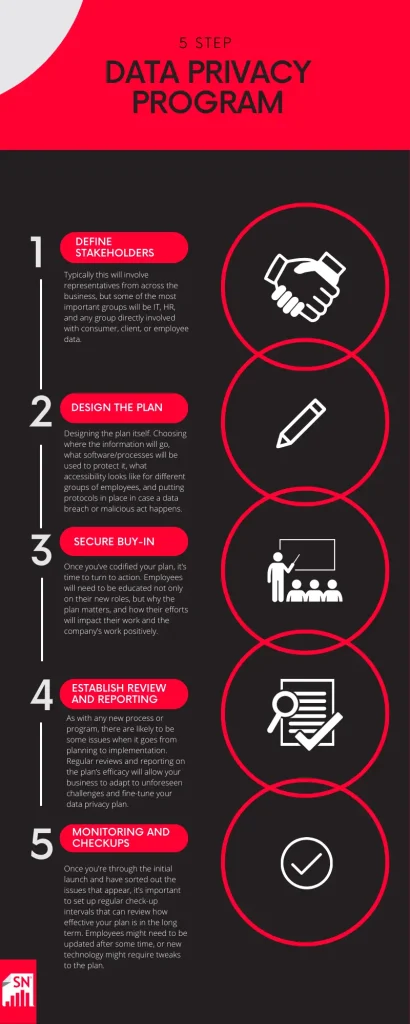
Data privacy seems to be everywhere. From corporations, to individuals, to governments, it seems like everyone is now aware and working to wrestle their data back under their control. For businesses, it’s becoming increasingly important to implement a data privacy program that protects both your company and its employees’ information.
With heightened risks of data breaches, increased turnover over the past few years, and an increasingly data aware consumer base, data protection and privacy are no longer buzzwords. Coupled with regulations like the GDPR, the CCPA, and more to come, the time is now for companies to invest and implement data privacy programs.
Evaluating Your Company’s Current Practices
The first step in designing anything new for your business is always the same, taking inventory of what you’ve got. It’s likely that you have a smattering of privacy programs and policies already in place, governing things like employee information, consumer information, proprietary information, and more.
If these are all connected under an overarching system, you’re already a step ahead. If not, don’t worry, that’s what a data privacy program will help solve.
Once you know what’s in place, it’s time to examine them in detail. What exactly do they cover, how do they cover it, and how do they line up with the best practices set out by the GDPR and the CCPA? While your business might not need to comply with these regulations, they’re a good starting point to determining what you should cover under a data privacy program.
Identifying Current Data Privacy Weaknesses
Once you’ve finished taking stock, it’s time to find the holes in your current practices. Is the protection of your employee’s data great, but your consumer information protection lax? These are tough questions to ask, but it’s better that it’s your company or consultants finding out the answers, and not a malicious actor.
These weaknesses should be made a priority when moving forward with your data privacy program, as any gap in the armor can create a launching point for a data breach. However, they shouldn’t be the only focus. Rather, they should be instructive in your design of the overall data privacy program. As the saying goes, you’re only as strong as your weakest link.
Understanding Your Company’s Specific Needs
While there are best practices that apply across industries and locations, there is no ‘one size fits all’ data privacy program. Regulations differ for businesses in different states, and they differ even more for those doing business in Europe. For international businesses, GDPR compliance should be a mandatory part of the plan, and for businesses that operate in California, CCPA should be as well.
After those starting points, it’s useful to identify what sort of data you’re collecting. Do you operate more with clients rather than consumers? What sort of data do you collect and retain from them? Where does that data go, is your client data stored in your sales system, accounts payable system, or both?
Think of this section as almost an audit of your data practices. While it’s in service of a data privacy program, it might also show you other actionable insights that you can use in your business as well.
Implementing a Data Privacy Program

The final step of the process is putting it all together. This will be the hardest part, and likely the most time consuming. It’s likely that this step will involve changes in processes and maybe even technology, which will require time and patience as your employees familiarize themselves with the new way of doing things.
The actual implementation of the plan can break down into 5 broad steps.
- Defining the stakeholders in the plan. Typically this will involve representatives from across the business, but some of the most important groups will be IT, HR, and any group directly involved with consumer, client, or employee data.
- Designing the plan itself. Choosing where the information will go, what software/processes will be used to protect it, what accessibility looks like for different groups of employees, and putting protocols in place in case a data breach or malicious act happens.
- Securing buy-in. Once you’ve codified your plan, it’s time to turn to action. Employees will need to be educated not only on their new roles, but why the plan matters, and how their efforts will impact their work and the company’s work positively.
- Establishing reviewing and reporting: As with any new process or program, there are likely to be some issues when it goes from planning to implementation. Regular reviews and reporting on the plan’s efficacy will allow your business to adapt to unforeseen challenges and fine-tune your data privacy plan.
- Monitoring and check-ups: Once you’re through the initial launch and have sorted out the issues that appear, it’s important to set up regular check-up intervals that can review how effective your plan is in the long term. Employees might need to be updated after some time, or new technology might require tweaks to the plan.
Shred Nations Helps Companies with Their Data Privacy
Shred Nations has been operating in the data privacy space for decades, and our trusted partners offer a range of services that can help your business implement a data privacy program. From paper shredding, to document storage, to document management, Shred Nations offers secure and affordable solutions that can strengthen your data privacy. Give us a call at (800) 747-3365, or fill out the form on the page, and we’ll help you get started on your data privacy program in just minutes.












